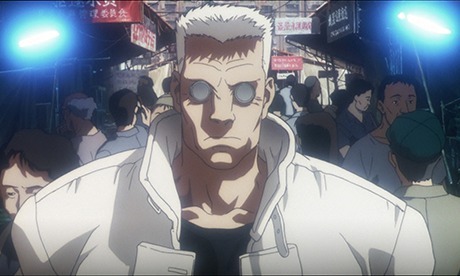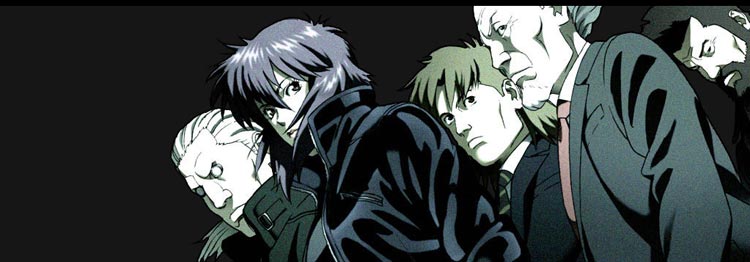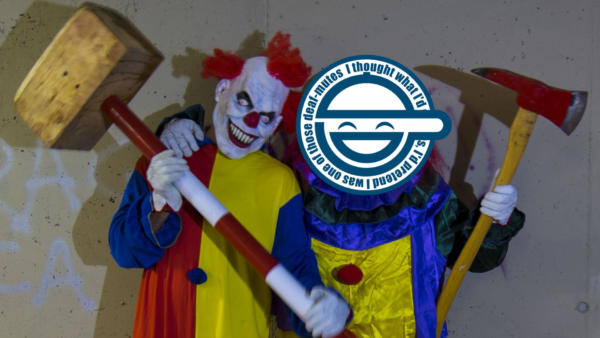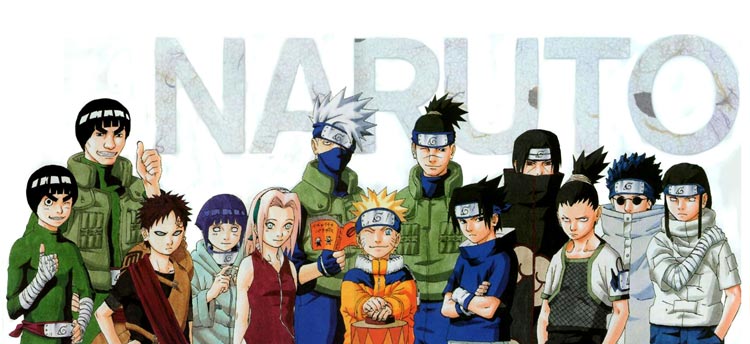![Glico's Osaka Office. By MASA (Own work) [GFDL (http://www.gnu.org/copyleft/fdl.html) or CC BY-SA 3.0 (http://creativecommons.org/licenses/by-sa/3.0)], via Wikimedia Commons](https://japanpowered.com/media/images//450px-Glico_Osaka_Office_1-225x300.jpg)
By MASA (Own work) [GFDL (http://www.gnu.org/copyleft/fdl.html) or CC BY-SA 3.0 (http://creativecommons.org/licenses/by-sa/3.0)], via Wikimedia Commons
While GitS is, of course, fiction, one story arc eerily echoes a strange case from real life. One of Section 9’s long running cases involved a character known simply as “The Laughing Man.” The case, which is far too complex to go into in depth here, involved a hacker who conducted a spree of cyber terror against high tech medical companies dealing in things called micro-machines. The terrorist’s symbol was that of a laughing face with a cap, with text scrolling around it that read: “I thought what I’d do was, I’d pretend I was one of those deaf-mutes.” The quote was lifted from J.D Salinger’s “Catcher in the Rye,” while the hacker’s pseudonym was taken from the title of another Salinger story.
The real life occurrence that, likely as not, at least partially inspired the story in GitS, occurred between 1984 and 1985. During this time, a shadowy figure (or figures) calling themselves “The Monster with 21 Faces”–a reference to a villain in a series of detective novels by Rampo Edogawa–terrorized Japanese food companies and the public at large. Police were helpless to stop the extortionists, whose identities remain unknown to this day.
The crime spree begins
The criminal’s first target was the president of Ezaki Glico, an Osaka-based candy company established in 1922. Named Katsuhisa Ezaki, on the night of May 18, 1984 two gunmen burst into his home and abducted him after terrorizing his family. The extortionists contacted Glico’s director the next day, demanding 1 billion yen (approximately $9.3 million dollars) and 220 pounds of gold bullion in exchange for Ezaki. However, after three days of captivity, the executive managed to escape the warehouse in Ibaraki before the deal could be made.
Their plans frustrated, the extortionists switched tactics. On April 10, three cars in the parking lot of Ezaki Glico’s trial production facility burst into flame. Six days later, police in Ibaraki prefecture discovered a threatening note taped to a jug of hydrochloric acid.
The next month, on May 10, the criminals contacted police directly with a letter signed “the Monster with 21 Faces.” It claimed that Glico candies laced with cyanide had been distributed to stores, prompting the company to enact a massive product recall. The company’s stocks took a beating on the stock exchange, and panic among the public began to mount.
For their part, the police had little to go on. The initial letter was written using hiragana, a writing style unique to Osaka. The criminals seemed to enjoy their growing notoriety, sending the police taunting letters. One such letter read: “You seem to be at a loss. So why not let us help you? We’ll give you a clue. We entered the factory by the front gate. The typewriter we used is Panwriter. The plastic container used was a piece of street garbage. Monster with 21 Faces.”
Even with this unwanted bit of help, the police were no closer to nabbing a suspect. While the police muddled on, the criminals shifted their sights to a new target.
The Monster strikes again
On June 26, police received a note proclaiming “We forgive Glico!” The extortionists began harassing Morinaga & Company, the House Food Coporation, and Marudai Ham with threatening letters. Marudai agreed to pay a ransom of 50 million yen. A policeman disguised as a Marudai employee would make the exchange, and hopefully catch one of the perpetrators in the process.
The extortionists ordered the money be tossed out of a train bound for Kyoto, where a white flag was stuck in the ground by the tracks. The drop was scheduled for June 28.
When the officer boarded his train at the appointed time, he spotted a suspicious man shadowing him. The stranger was a large man with short, permed hair and glasses. His eyes, according to the officer, were like a fox’s.
The white flag never materialized, and the officer and his shadow disembarked in Kyoto, only to board the next train to Osaka. Another officer was waiting back at the station in Osaka, but both managed to somehow lose the suspect when he boarded a train to Kyoto.
“Moms of the Nation”
The extortionists entered a new and even more despicable phase of their crimes in October of 1984. The Monster with 21 Faces sent letters to Osaka news agencies addressed to “Moms of the Nation,” claiming that Morinaga candy had been spiked with cyanide and placed in random stores all over Japan. Amid growing fear, searches lasting until February the following year turned up 21 packages of tainted candy. The criminals had helpfully labeled the suspect packages with warning labels that read: “Danger: Contains Toxins.”
While the search for tainted candy was ongoing, executives with House Food planned a ransom exchange. This time, the Monster asked for 100 million yen. The drop would occur at a rest stop on the Meishin Expressway in Shiga Prefecture. Officers with the local prefectural police spotted a man who they thought was the fox-eyed fellow from the previous drop. Officers attempted to apprehend the suspect, but he managed to elude them yet again. They found his vehicle, which was stolen, dumped at the Kusatsu railroad station. Inside, they found a police radio scanner which the suspect had used to monitor police activity and thus escape his would-be captors.
A break in the case?
Frustrated by their lack of progress, in January 1985 police published a composite sketch of the suspect who had twice eluded them. After a few days of circulating the sketch, Tokyo turned up the first tangible suspect so far in the case. Named Miyazaki Manubu, he was a whistle-blower who, in 1975-6, exposed Glico’s dumping of industrial water into rivers in Osaka. Police claimed that an audiotape dating from 1976 echoed wording of letters written by the Monster with 21 Faces. However, after investigating Manubu, police found his alibis checked out for the various crimes and were forced to exonerate him.
Frustration grew among police investigating the case, reaching tragic proportions. On August 7, 1985, Superintendent Yamamoto of the Shiga Prefecture police doused himself in gasoline and lit himself on fire. Five days later, the Monster sent his last letter:
“Yamamoto of Shiga Prefecture Police Died. How stupid of him! We’ve got no friends or secret hiding place in Shiga. It’s Yoshino or Shikata who should have died. What have they been doing for as long as one year and five months? Don’t let bad guys like us get away with it. There are many more fools who want to copy us. No-career Yamamoto died like a man. So we decide to give our condolence. We decided to forget about torturing food-making companies. If anyone blackmails any of the food-making companies, it’s not us but someone copying us. We are bad guys. that means we’ve got more to do than bullying companies. it’s fun to lead a bad man’s life. Monster with 21 Faces.”
The current state of the case
In the nearly thirty years since the Monster with 21 Faces perpetrated his crimes, no new leads have come to light. As the taunting letter foretold, there have been many imitators in the years since. Altogether, there have been a total of 525 cases of extortion attempts against food producers, of which 322 have been solved. The most recent was a case from just last year, when a man identifying himself as Kaijin 28-go (Phantom #28) attempted to extort 50 million yen from Ezaki Glico Co. among other manufacturers. The suspect was captured, and is regarded as a copycat of the original Monster with 21 Faces.
As for the original Monster, he or they are free and clear. The statute of limitations on Ezaki’s kidnapping case ran out in 1995, and the last deadline for the poisonings and other crimes attributed to the Monster ran out in 2000. This despite massive efforts at the time, involving over a million officers who interviewed over 12,000 suspects. The case remains a massive black eye to Japan’s National Police Agency, and an enduring mystery that is subject to as much obsessive study as the fictional Laughing Man was among amateur sleuths in Ghost in the Shell.
Any attempt to establish the true motives and identity of the Monster is pure speculation. Some pin the crimes on the Yakuza crime syndicate, while others suspect North Korean agents attempted to disrupt the Japanese economy. The former theory is more plausible, given the sophistication of the Yakuza’s criminal network. Then again, such a secretive organization is not likely to want to draw attention to itself on a national level.
Another theory is that the whole scheme was an attempt to secure a stock windfall. No doubt, the negative press garnered from the whole affair would make the stocks of the various companies drop. Who is to say that shady investors did not form a cabal and pay off lackeys to commit the crimes, only to buy up stocks when their value sank and then make a healthy profit when they bounced back? Such a scheme would be difficult to track, as it could conceivably be perceived as simply a good investment strategy on the part of savvy business people.
But, again, this is nothing more than speculation. Until the perpetrators behind the crimes come forward, only they will know the true identity of the Monster with 21 Faces.
Sources:
“Arrest made in poisoning threat of Glico products, possible copycat from 30 years ago.” ajw.asahi.com. December 01, 2014. The Asahi Shimbum. February 15, 2015. http://ajw.asahi.com/article/behind_news/social_affairs/AJ201412010052
“Clock ticking on Glico-Morinaga cases.” Japantimes.co.jp. February 24, 1999. The Japan Times. February 15, 2015. http://www.japantimes.co.jp/news/1999/02/24/national/clock-ticking-on-glico-morinaga-cases/#.VOn3ri4Qk8I
Newton, Michael. “The Encyclopedia of Unsolved Crimes.” Infobase Publishing, 2009. pgs 136-137.
“NPA admits defeat in Glico-Morinaga case.” Japantimes.co.jp. February 10, 2000. The Japan Times. February 15, 2015. http://www.japantimes.co.jp/news/2000/02/10/national/npa-admits-defeat-in-glico-morinaga-case/#.VOn3pi4Qk8I



